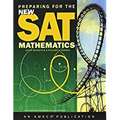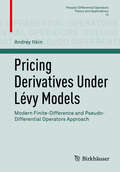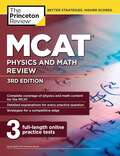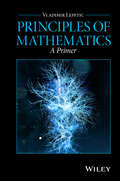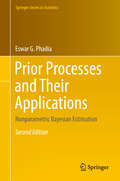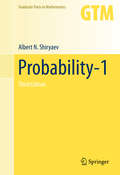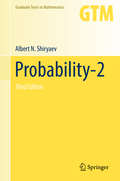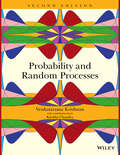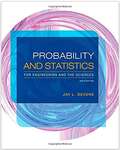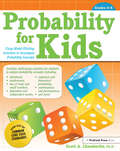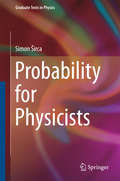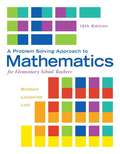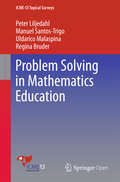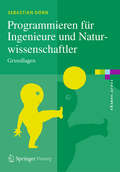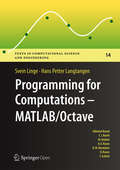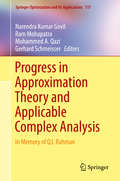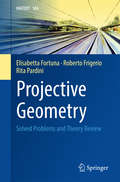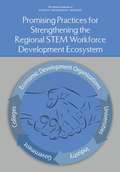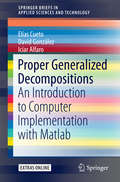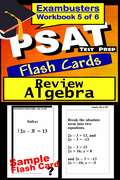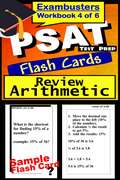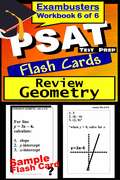- Table View
- List View
Preparing for the New SAT: Mathematics Student Edition
by Joyce Bernstein Richard J. AndresNIMAC-sourced textbook
Preschool Math at Home: Simple Activities to Build the Best Possible Foundation for Your Child
by Kate SnowGiving your preschooler a great start in math doesn’t have to be complicated. Learn how to use fun but purposeful games and activities to give your young child the best possible foundation. Preschool Math at Home will guide you step-by-step as you introduce your preschooler to the world of numbers. Your child will develop a thorough understanding of the numbers up to ten, including: counting comparing and ordering numbers recognizing written numerals beginning addition and subtraction All of the activities are quick and playful, with lots of movement, manipulatives, and games. Each takes less than five minutes, with no special materials needed other than a few household items. Play each game several times for a full year of preschool math curriculum.
Pricing Derivatives Under Lévy Models
by Andrey ItkinThis monograph presents a novel numerical approach to solving partial integro-differential equations arising in asset pricing models with jumps, which greatly exceeds the efficiency of existing approaches. The method, based on pseudo-differential operators and several original contributions to the theory of finite-difference schemes, is new as applied to the L#65533;vy processes in finance, and is herein presented for the first time in a single volume. The results within, developed in a series of research papers, are collected and arranged together with the necessary background material from L#65533;vy processes, the modern theory of finite-difference schemes, the theory of M-matrices and EM-matrices, etc. , thus forming a self-contained work that gives the reader a smooth introduction to the subject. For readers with no knowledge of finance, a short explanation of the main financial terms and notions used in the book is given in the glossary. The latter part of the book demonstrates the efficacy of the method by solving some typical problems encountered in computational finance, including structural default models with jumps, and local stochastic volatility models with stochastic interest rates and jumps. The author also adds extra complexity to the traditional statements of these problems by taking into account jumps in each stochastic component while all jumps are fully correlated, and shows how this setting can be efficiently addressed within the framework of the new method. Written for non-mathematicians, this book will appeal to financial engineers and analysts, econophysicists, and researchers in applied numerical analysis. It can also be used as an advance course on modern finite-difference methods or computational finance.
Primary Mathematics
by Serow, Penelope and Callingham, Rosemary and Muir, Tracey Penelope Serow Rosemary Callingham Tracey MuirPrimary Mathematics provides a comprehensive introduction to teaching and learning mathematics in today's classrooms. Drawing links to the Australian Curriculum, this book covers the core learning areas of measurement, space and geometry, early number concepts, data and statistics, chance and probability, and patterns and algebra. At the centre of this book is the belief that ICT can be a powerful tool for enhancing student learning. Although many classrooms have been resourced with computers, interactive whiteboards and mobile technology, teachers need to be able to transform these technological tools into meaningful teaching and learning experiences. This book explores the ways in which technology can be integrated into the mathematics classroom. The book also explores issues around student diversity, assessment 'for', 'of' and 'as' learning, and teaching in rural and remote areas. Primary Mathematics is an indispensable resource for pre- and in-service teachers alike.
Prime Numbers and the Riemann Hypothesis
by Barry Mazur William SteinPrime numbers are beautiful, mysterious, and beguiling mathematical objects. The mathematician Bernhard Riemann made a celebrated conjecture about primes in 1859, the so-called Riemann Hypothesis, which remains to be one of the most important unsolved problems in mathematics. Through the deep insights of the authors, this book introduces primes and explains the Riemann Hypothesis. Students with minimal mathematical background and scholars alike will enjoy this comprehensive discussion of primes. The first part of the book will inspire the curiosity of a general reader with an accessible explanation of the key ideas. The exposition of these ideas is generously illuminated by computational graphics that exhibit the key concepts and phenomena in enticing detail. Readers with more mathematical experience will then go deeper into the structure of primes and see how the Riemann Hypothesis relates to Fourier analysis using the vocabulary of spectra. Readers with a strong mathematical background will be able to connect these ideas to historical formulations of the Riemann Hypothesis.
The Princeton Review® MCAT® Physics and Math Review (Graduate School Test Preparation)
by Princeton StaffInside this book, you'll find proven strategies for tackling and overcoming challenging questions, along with all the practice you need to help get the score you want. Everything You Need to Know to Help Achieve a High Score. * In-depth coverage of the challenging physics & math topics on this important test * Sample MCAT questions with step-by-step walk-through explanations * Bulleted chapter summaries for quick review * Full-color illustrations, diagrams, and tables * Extensive glossary for handy reference Practice Your Way to Excellence. * Access to 3 full-length practice tests online to help you gauge your progress * End-of-chapter drills and explanations * MCAT-style practice passages and questions * Test-taking strategies geared toward physics and math mastery Gain Mastery of These and Other Topics! * Kinematics * Mechanics * Fluids and Elasticity of Solids * Electrostatics * Electricity and Magnetism * Oscillations and Waves * Sound * Light and Geometrical Optics
Principles of Mathematics
by Vladimir LepeticPresents a uniquely balanced approach that bridges introductory and advanced topics in modern mathematics An accessible treatment of the fundamentals of modern mathematics, Principles of Mathematics: A Primer provides a unique approach to introductory andadvanced mathematical topics. The book features six main subjects, whichcan be studied independently or in conjunction with each other including: settheory; mathematical logic; proof theory; group theory; theory of functions; andlinear algebra. The author begins with comprehensive coverage of the necessary building blocks in mathematics and emphasizes the need to think abstractly and develop an appreciation for mathematical thinking. Maintaining a useful balance of introductory coverage and mathematical rigor, Principles of Mathematics: A Primer features: Detailed explanations of important theorems and their applications Hundreds of completely solved problems throughout each chapter Numerous exercises at the end of each chapter to encourage further exploration Discussions of interesting and provocative issues that spark readers' curiosity and facilitate a better understanding and appreciation of the field of mathematics Principles of Mathematics: A Primer is an ideal textbook for upper-undergraduate courses in the foundations of mathematics and mathematical logic as well as for graduate-level courses related to physics, engineering, and computer science. The book is also a useful reference for readers interested in pursuing careers in mathematics and the sciences. Vladimir Lepetic, PhD, is Professor in the Department of Mathematical Sciences at DePaul University. His research interests include mathematical physics, set theory, foundations of mathematics, and the philosophy of mathematics.
Prior Processes and Their Applications
by Eswar G. PhadiaThis book presents a systematic and comprehensive treatment of various prior processes that have been developed over the past four decades for dealing with Bayesian approach to solving selected nonparametric inference problems. This revised edition has been substantially expanded to reflect the current interest in this area. After an overview of different prior processes, it examines the now pre-eminent Dirichlet process and its variants including hierarchical processes, then addresses new processes such as dependent Dirichlet, local Dirichlet, time-varying and spatial processes, all of which exploit the countable mixture representation of the Dirichlet process. It subsequently discusses various neutral to right type processes, including gamma and extended gamma, beta and beta-Stacy processes, and then describes the Chinese Restaurant, Indian Buffet and infinite gamma-Poisson processes, which prove to be very useful in areas such as machine learning, information retrieval and featural modeling. Tailfree and Polya tree and their extensions form a separate chapter, while the last two chapters present the Bayesian solutions to certain estimation problems pertaining to the distribution function and its functional based on complete data as well as right censored data. Because of the conjugacy property of some of these processes, most solutions are presented in closed form. However, the current interest in modeling and treating large-scale and complex data also poses a problem - the posterior distribution, which is essential to Bayesian analysis, is invariably not in a closed form, making it necessary to resort to simulation. Accordingly, the book also introduces several computational procedures, such as the Gibbs sampler, Blocked Gibbs sampler and slice sampling, highlighting essential steps of algorithms while discussing specific models. In addition, it features crucial steps of proofs and derivations, explains the relationships between different processes and provides further clarifications to promote a deeper understanding. Lastly, it includes a comprehensive list of references, equipping readers to explore further on their own.
Probability-1
by Albert N. ShiryaevAdvanced maths students have been waiting for this, the third edition of a text that deals with one of the fundamentals of their field. This book contains a systematic treatment of probability from the ground up, starting with intuitive ideas and gradually developing more sophisticated subjects, such as random walks and the Kalman-Bucy filter. Examples are discussed in detail, and there are a large number of exercises. This third edition contains new problems and exercises, new proofs, expanded material on financial mathematics, financial engineering, and mathematical statistics, and a final chapter on the history of probability theory.
Probability-2: Applications (Graduate Texts in Mathematics #900)
by Albert N. ShiryaevThis textbook is the second volume of a pair that presents the latest English edition of the author’s classic, Probability. Building on the foundations established in the preceding Probability-1, this volume guides the reader on to the theory of random processes. The new edition includes expanded material on financial mathematics and financial engineering; new problems, exercises, and proofs throughout; and a Historical Review charting the development of the mathematical theory of probability. Suitable for an advanced undergraduate or beginning graduate student with a course in probability theory, this volume forms the natural sequel to Probability-1. <P><P> Probability-2 opens with classical results related to sequences and sums of independent random variables, such as the zero–one laws, convergence of series, strong law of large numbers, and the law of the iterated logarithm. The subsequent chapters go on to develop the theory of random processes with discrete time: stationary processes, martingales, and Markov processes. The Historical Review illustrates the growth from intuitive notions of randomness in history through to modern day probability theory and theory of random processes. <P><P> Along with its companion volume, this textbook presents a systematic treatment of probability from the ground up, starting with intuitive ideas and gradually developing more sophisticated subjects, such as random walks, martingales, Markov chains, the measure-theoretic foundations of probability theory, weak convergence of probability measures, and the central limit theorem. Many examples are discussed in detail, and there are a large number of exercises throughout.
Probability and Random Processes
by Kavitha Chandra Venkatarama KrishnanThe second edition enhanced with new chapters, figures, and appendices to cover the new developments in applied mathematical functions This book examines the topics of applied mathematical functions to problems that engineers and researchers solve daily in the course of their work. The text covers set theory, combinatorics, random variables, discrete and continuous probability, distribution functions, convergence of random variables, computer generation of random variates, random processes and stationarity concepts with associated autocovariance and cross covariance functions, estimation theory and Wiener and Kalman filtering ending with two applications of probabilistic methods. Probability tables with nine decimal place accuracy and graphical Fourier transform tables are included for quick reference. The author facilitates understanding of probability concepts for both students and practitioners by presenting over 450 carefully detailed figures and illustrations, and over 350 examples with every step explained clearly and some with multiple solutions. Additional features of the second edition of Probability and Random Processes are: Updated chapters with new sections on Newton-Pepys' problem; Pearson, Spearman, and Kendal correlation coefficients; adaptive estimation techniques; birth and death processes; and renewal processes with generalizations A new chapter on Probability Modeling in Teletraffic Engineering written by Kavitha Chandra An eighth appendix examining the computation of the roots of discrete probability-generating functions With new material on theory and applications of probability, Probability and Random Processes, Second Edition is a thorough and comprehensive reference for commonly occurring problems in probabilistic methods and their applications.
Probability and Statistics for Engineering and the Sciences
by Jay L. DevorePut statistical theories into practice with PROBABILITY AND STATISTICS FOR ENGINEERING AND THE SCIENCES, 9th Edition. Always a favorite with statistics students, this calculus-based text offers a comprehensive introduction to probability and statistics while demonstrating how professionals apply concepts, models, and methodologies in today's engineering and scientific careers. <p><p>Jay Devore, an award-winning professor and internationally recognized author and statistician, emphasizes authentic problem scenarios in a multitude of examples and exercises, many of which involve real data, to show how statistics makes sense of the world. Mathematical development and derivations are kept to a minimum. <p><p>The book also includes output, graphics, and screen shots from various statistical software packages to give you a solid perspective of statistics in action. A Student Solutions Manual, which includes worked-out solutions to almost all the odd-numbered exercises in the book, is available.
Probability for Kids: Using Model-Eliciting Activities to Investigate Probability Concepts (Grades 4-6)
by Scott ChamberlinProbability for Kids features real-world probability scenarios for students in grades 4-6. Students will encounter problems in which they read about students their age selling magazines for a school fund raiser, concerned about their homeroom assignments, and trying to decode the combination to a safe that their grandfather abandoned, among others, all of which maximizes learning so students gain a deep understanding of concepts in probability. This book will help teachers, parents, and other educators to employ best practices in implementing challenging math activities based on standards. Problem solvers who complete all six activities in the book will understand the six basic principles of probability and be high school ready for discussions in probability. Grades 4-6
Probability for Physicists
by Simon SircaThis book is designed as a practical and intuitive introduction to probability, statistics and random quantities for physicists. The book aims at getting to the main points by a clear, hands-on exposition supported by well-illustrated and worked-out examples. A strong focus on applications in physics and other natural sciences is maintained throughout. In addition to basic concepts of random variables, distributions, expected values and statistics, the book discusses the notions of entropy, Markov processes, and fundamentals of random number generation and Monte-Carlo methods.
A Problem Solving Approach To Mathematics For Elementary School Teachers
by Rick Billstein Shlomo Libeskind Johnny LottA Problem Solving Approach to Mathematics for Elementary School Teachers
Problem Solving in Mathematics Education
by Peter Liljedahl Manuel Santos-Trigo Uldarico Malaspina Regina BruderThis survey book reviews four interrelated areas: (i) the relevance of heuristics in problem-solving approaches why they are important and what research tells us about their use; (ii) the need to characterize and foster creative problem-solving approaches what type of heuristics helps learners devise and practice creative solutions; (iii) the importance that learners formulate and pursue their own problems; and iv) the role played by the use of both multiple-purpose and ad hoc mathematical action types of technologies in problem-solving contexts what ways of reasoning learners construct when they rely on the use of digital technologies, and how technology and technology approaches can be reconciled. "
Programmieren für Ingenieure und Naturwissenschaftler: Grundlagen (eXamen.press)
by Sebastian DörnZiel des Buches ist es, Studierenden der Ingenieur- oder Naturwissenschaften die Programmierung als Schlüsselqualifikation mit zahlreichen Anwendungsmöglichkeiten vorzustellen. Die Umsetzung von Programmierkonzepten und algorithmischen Verfahren erfolgt in diesem Buch in Java. Im ersten Teil gibt der Autor eine Einführung in die Grundkonzepte von Java, im zweiten Teil werden algorithmische Verfahren aus dem Bereich der Numerik, sowie allgemeine Methoden zum Entwurf von Algorithmen vorgestellt. Im dritten Teil werden Grundlagen der objektorientierten Programmierung dargestellt sowie ein Überblick über die Erstellung von graphischen Benutzeroberflächen gegeben. Ein Kapitel zu diversen Anwendungen aus dem Bereich der Ingenieur- und Naturwissenschaften sowie Aufgaben und Lösungen in jedem Kapitel runden das Buch ab.
Programming for Computations - MATLAB/Octave
by Svein Linge Hans Petter LangtangenThis book presentscomputer programming as a keymethod for solving mathematical problems. There are two versions of the book,one for MATLAB and onefor Python. The book wasinspired by the Springer bookTCSE 6: A Primer on Scientific Programming with Python (by Langtangen), but the style is more accessible andconcise, in keeping with the needs of engineering students. The book outlines the shortest possible path from no previous experience with programming to a set ofskills that allows the students to write simple programs for solving commonmathematical problems withnumerical methods in engineering and science courses. The emphasis is on generic algorithms, cleandesign of programs, use of functions, and automatic tests for verification.
Progress in Approximation Theory and Applicable Complex Analysis
by Narendra Kumar Govil Ram Mohapatra Mohammed A. Qazi Gerhard SchmeisserCurrent and historical research methods in approximation theory are presented in this book beginning with the 1800s and following the evolution of approximation theory via the refinement and extension of classical methods and ending with recent techniques and methodologies. Graduate students, postdocs, and researchers in mathematics, specifically those working in the theory of functions, approximation theory, geometric function theory, and optimization will find new insights as well as a guide to advanced topics. The chapters in this book are grouped into four themes; the first, polynomials (Chapters 1 -8), includes inequalities for polynomials and rational functions, orthogonal polynomials, and location of zeros. The second, inequalities and extremal problems are discussed in Chapters 9 -13. The third, approximation of functions, involves the approximants being polynomials, rational functions, and other types of functions and are covered in Chapters 14 -19. The last theme, quadrature, cubature and applications, comprises the final three chapters and includes an article coauthored by Rahman. This volume serves as a memorial volume to commemorate the distinguished career of Qazi Ibadur Rahman (1934-2013) of the Universit#65533; de Montr#65533;al. Rahman was considered by his peers as one of the prominent experts in analytic theory of polynomials and entire functions. The novelty of his work lies in his profound abilities and skills in applying techniques from other areas of mathematics, such as optimization theory and variational principles, to obtain final answers to countless open problems.
Projective Geometry
by Elisabetta Fortuna Roberto Frigerio Rita PardiniThis book starts with a concise but rigorous overview of the basic notions of projective geometry, using straightforward and modern language. The goal is not only to establish the notation and terminology used, but also to offer the reader a quick survey of the subject matter. In the second part, the book presents more than 200 solved problems, for many of which several alternative solutions are provided. The level of difficulty of the exercises varies considerably: they range from computations to harder problems of a more theoretical nature, up to some actual complements of the theory. The structure of the text allows the reader to use the solutions of the exercises both to master the basic notions and techniques and to further their knowledge of the subject, thus learning some classical results not covered in the first part of the book. The book addresses the needs of undergraduate and graduate students in the theoretical and applied sciences, and will especially benefit those readers with a solid grasp of elementary Linear Algebra.
Promising Practices for Strengthening the Regional STEM Workforce Development Ecosystem
by National Academies of Sciences Engineering MedicineU.S. strength in science, technology, engineering, and mathematics (STEM) disciplines has formed the basis of innovations, technologies, and industries that have spurred the nation’s economic growth throughout the last 150 years. Universities are essential to the creation and transfer of new knowledge that drives innovation. This knowledge moves out of the university and into broader society in several ways — through highly skilled graduates (i.e. human capital); academic publications; and the creation of new products, industries, and companies via the commercialization of scientific breakthroughs. Despite this, our understanding of how universities receive, interpret, and respond to industry signaling demands for STEM-trained workers is far from complete. Promising Practices for Strengthening the Regional STEM Workforce Development Ecosystem reviews the extent to which universities and employers in five metropolitan communities (Phoenix, Arizona; Cleveland, Ohio; Montgomery, Alabama; Los Angeles, California; and Fargo, North Dakota) collaborate successfully to align curricula, labs, and other undergraduate educational experiences with current and prospective regional STEM workforce needs. This report focuses on how to create the kind of university-industry collaboration that promotes higher quality college and university course offerings, lab activities, applied learning experiences, work-based learning programs, and other activities that enable students to acquire knowledge, skills, and attributes they need to be successful in the STEM workforce. The recommendations and findings presented will be most relevant to educators, policy makers, and industry leaders.
Proper Generalized Decompositions
by Elías Cueto David González Icíar AlfaroThis book is intended to help researchers overcome the entrance barrier to Proper Generalized Decomposition (PGD), by providing a valuable tool to begin the programming task. Detailed Matlab Codes are included for every chapter in the book, in which the theory previously described is translated into practice. Examples include parametric problems, non-linear model order reduction and real-time simulation, among others. Proper Generalized Decomposition (PGD) is a method for numerical simulation in many fields of applied science and engineering. As a generalization of ProperOrthogonal Decomposition or Principal Component Analysis to an arbitrary numberof dimensions, PGD is able to provide the analyst with very accurate solutionsfor problems defined in high dimensional spaces, parametric problems and evenreal-time simulation.
PSAT Test Prep Flash Card Review: Algebra Review (Exambusters PSAT Workbook #5 of 6)
by Ace Inc.<P><P><i>Advisory: Bookshare has learned that this book offers only partial accessibility. We have kept it in the collection because it is useful for some of our members. Benetech is actively working on projects to improve accessibility issues such as these.</i><P><P> 450 questions and answers that highlight introductory algebra definitions, problems, and concepts. <P><P>Topics: Algebraic Concepts, Sets, Variables, Exponents, Properties of Numbers, Simple Equations, Signed Numbers, Monomials, Polynomials, Additive and Multiplicative Inverse, Word Problems, Prime Numbers, Factoring, Algebraic Fractions, Ratio and Proportion, Variation, Radicals, Quadratic Equations <P>EXAMBUSTERS PSAT Prep Workbooks provide comprehensive, fundamental PSAT review--one fact at a time--to prepare students to take practice PSAT tests. Each PSAT study guide focuses on one specific subject area covered on the PSAT exam. From 300 to 600 questions and answers, each volume in the PSAT series is a quick and easy, focused read. Reviewing PSAT flash cards is the first step toward more confident PSAT preparation and ultimately, higher PSAT exam scores!
PSAT Test Prep Flash Cards: Arithmetic Review (Exambusters PSAT Workbook #4 of 6)
by Ace Inc.<P><P><i>Advisory: Bookshare has learned that this book offers only partial accessibility. We have kept it in the collection because it is useful for some of our members. Benetech is actively working on projects to improve accessibility issues such as these.</i><P><P> 600 questions and answers highlight essential arithmetic definitions, problems, and concepts.<P><P> Topics: Addition, Subtraction, Multiplication, and Division of Whole Numbers; Fractions and Decimals, Multiplication Tables, Word Problems, Percents, Measurement, Metric System, Square Roots and Powers, Real Numbers, Properties of Numbers <P>EXAMBUSTERS PSAT Prep Workbooks provide comprehensive, fundamental PSAT review--one fact at a time--to prepare students to take practice PSAT tests. Each PSAT study guide focuses on one specific subject area covered on the PSAT exam. From 300 to 600 questions and answers, each volume in the PSAT series is a quick and easy, focused read. Reviewing PSAT flash cards is the first step toward more confident PSAT preparation and ultimately, higher PSAT exam scores!
PSAT Test Prep Flash Cards: Geometry Review (Exambusters PSAT Workbook #6 of 6)
by Ace Inc.<P><P><i>Advisory: Bookshare has learned that this book offers only partial accessibility. We have kept it in the collection because it is useful for some of our members. Benetech is actively working on projects to improve accessibility issues such as these.</i><P><P> 450 questions and answers that focus on essential geometry theorems, postulates, concepts, and definitions. Includes complementary diagrams. <P><P>Topics: Lines and Angles, Triangles, Proofs, Perpendicular Lines, Parallel Lines, Angle Sums, Quadrilaterals, Medians, Altitudes and Bisectors, Circles, Ratio and Proportion, Similar Polygons, Circles and Regular Polygons, Coordinate Geometry <P>EXAMBUSTERS PSAT Prep Workbooks provide comprehensive, fundamental PSAT review--one fact at a time--to prepare students to take practice PSAT tests. Each PSAT study guide focuses on one specific subject area covered on the PSAT exam. From 300 to 600 questions and answers, each volume in the PSAT series is a quick and easy, focused read. Reviewing PSAT flash cards is the first step toward more confident PSAT preparation and ultimately, higher PSAT exam scores!
